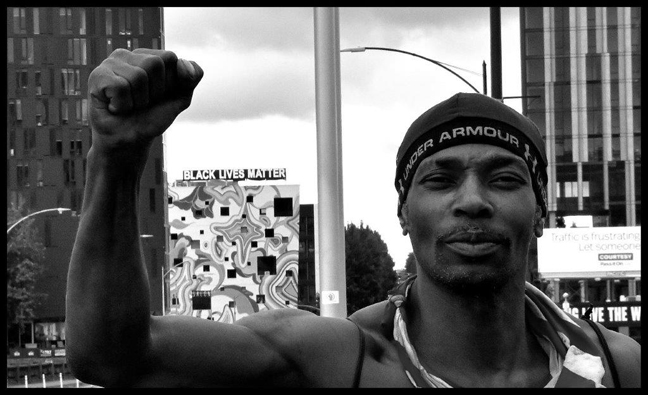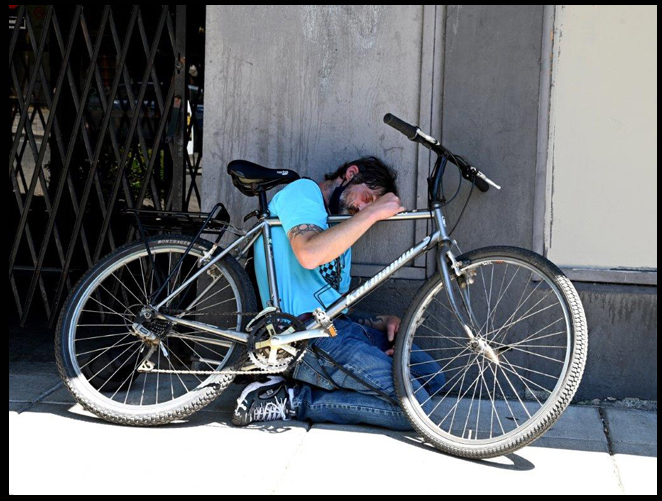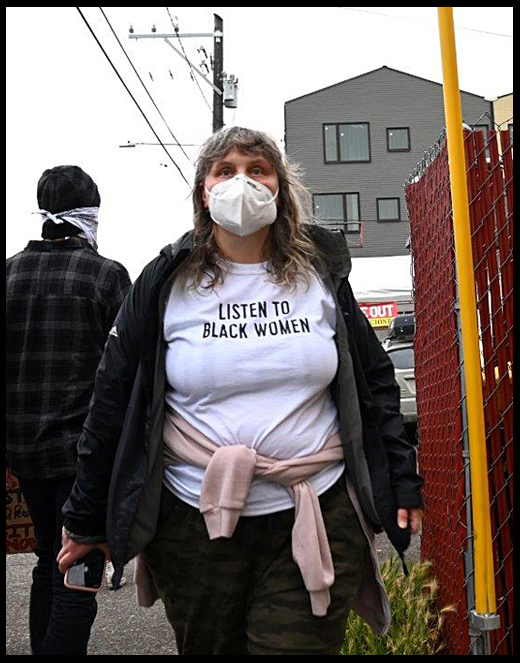Herds of rhinoceroses rushing at top speed through the streets became a sight that no longer surprised anybody. People would stand aside to let them pass and then resume their stroll, or attend to their business, as if nothing had happened.
– Eugene Ionesco, “Rhinoceros”
Few can hold a candle to Vietnam veteran medic Mike Hastie’s commitment to speaking Truth to Power about the Vietnam War and a host of other “crimes” the US Military has undertaken in the name of the American people. Mike was recently featured in a video in which he was shot in the eyes with a non-lethal pepper spray slime for speaking his truth non-violently to a phalanx of camouflaged, de-humanized, up-armored federal police in Portland, Oregon.
[ For a larger image of the video, above, watch it on You Tube. ]
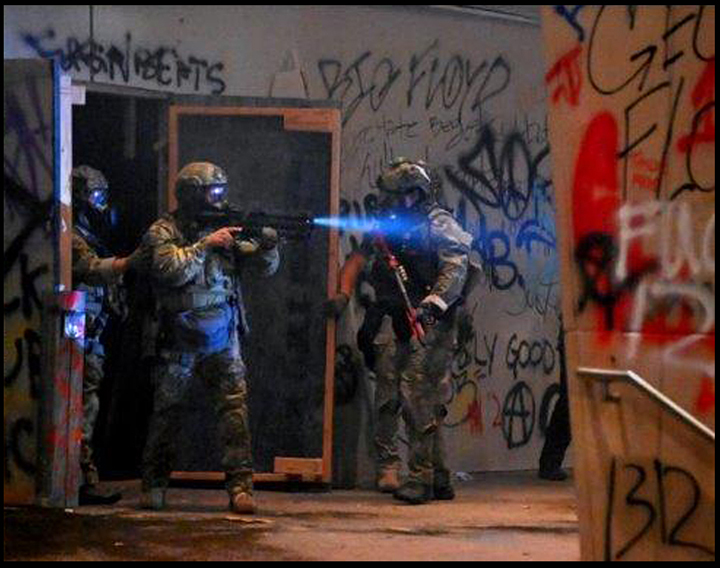
[ Top, Homeland Security operatives in action. Below left, the 75-year-old Mike Hastie after being slammed to the ground by cops. At right, Hastie taking photos very non-violently. Photo, right, by Dan Shea. ]
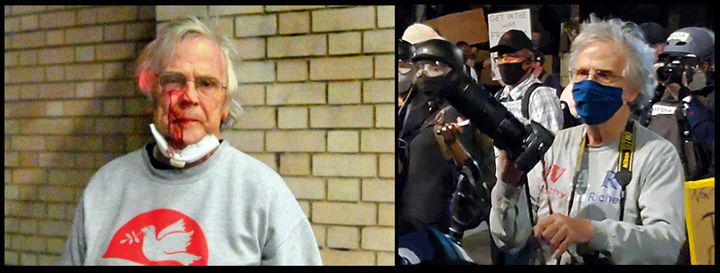
Hastie was specifically speaking his truth about the Vietnam War, a war he participated in many years ago before these up-armored young federal agents were even born. These obedient young state operatives are symbols of federal power assigned to “trump” local power for the purpose of intimidating First-Amendment protected protesters like Mike Hastie from expressing their truths. Naturally, they employ the very latest non-lethal tools of control.
While intense street confrontations like the one in Portland were inspired by the police murder of George Floyd, that spark set off a movement that quickly spread to involve a host of deeply exasperating issues that have plagued many Americans for a long time. For Vietnam veterans like Hastie, the Vietnam War is one of those issues. The same goes for young Americans fed up with the business-as-usual litany of unaddressed problems that threaten to foreclose their futures and turn them into nightmares. Much of this dissatisfaction is glibly reduced by the comfortable who have achieved their American dream to charges of “radicalism”, thereby making protester complaints easily dismissable and ignorable. And any examples of excessive anger by frustrated protesters easily damnable. Systematic racism, brutal policing and imperial militarism tend to get all mixed up in this volatile stew. To me, the assault on Mike Hastie is a small, telling set-piece in this drama.
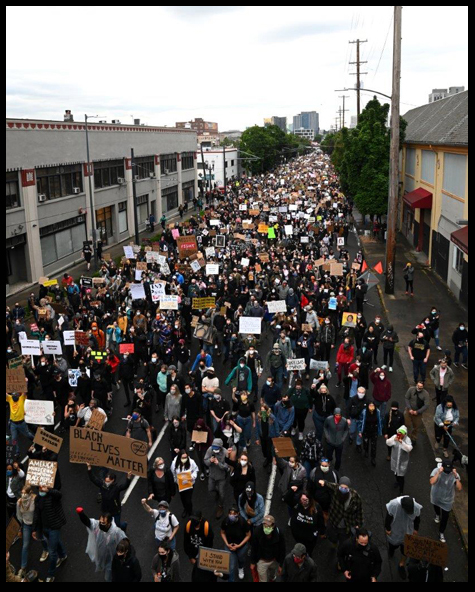
[ An early Hastie image of the Portland street protests. ]
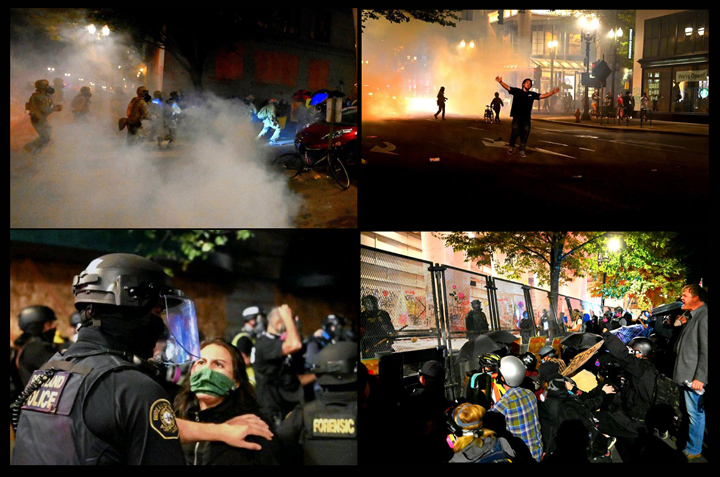
[ Four of Hastie’s many images from the Battle Of Portland. ]
The country still hasn’t reached any kind of consensus on the meaning of its bloody and costly adventure in Vietnam from 1945 to 1975. It just lives there dead-center in the post-WWII American story. Our aircraft carriers are now making port calls in Da Nang, and we’re allied with the Vietnamese vis-à-vis the Chinese. Some of us wonder why so-called great leaders like Harry Truman never considered this in 1945 when the US chose to support French re-colonization, despite the fact during WWII French forces had capitulated to the Japanese and the Viet Minh guerrillas had been our ally against the Japanese. I regularly ask people, but they can never tell me what exactly the Vietnamese ever did to us in the United States that required us to do what we did to them — the horrific things in the video Hastie is trying to tell the young men and women in the fashion accoutrements of 21st century fascism. You can see their brute passivity is making Mike angrier and angrier. In the end, by exhibiting so much anger, Mike is not being perfectly Gandhian; but Gandhi was not always Gandhian either.
This street confrontation writ large in US culture — what I’d call The American Vietnam War Divide — will be with us for the foreseeable future. At least until the last Vietnam vet expires. On one extreme, the Vietnam War is seen as an honorable affair, while on the other extreme, it’s an international crime.
The asymmetrical power confrontation between Hastie and the Homeland Security squad is a cliché of our time. Such a show of rhinoceros-like force never really solves anything; instead, it only circles back and feeds more dissatisfaction, more anger and more confrontation. Look at Belarus right now. In the US, it all began with the movable cattle chutes and “free-speech zones” of police operations following 9/11, all inspired by the so-called Patriot Act, that reactionary legislative construct that few legislators even read. The bottom line is lots of citizen tax money and expensive R&D has gone into discovering brilliant ways and means to restrict angry citizens’ First Amendment rights to speak truth to their government. Short of killing them.
Some years ago, 60 Minutes did a story on non-lethal sound-focusing guns for crowd control. My wife and I watched it, and before long we were both cursing the screen. Tank-mounted emitters were shown blasting sonic rays at volunteer soldiers in civilian clothes walking across a field carrying signs calling for — wha’d’ya know! — WORLD PEACE. These guinea-pig phony peace activists seemed to be having a really good time. The tank operator blasted the heroic 60 Minutes correspondent, and boy did he jump and snigger in awe at the incredible pain the thing caused. Wow! Ha! Ha! That really makes you move outa the way! Welcome to the brave new world of non-lethal crowd control. Not only did the Pentagon get 60 Minutes to promote its nifty new non-lethal weapon, it got them to ridicule the peace movement at the same time. I recall my furious, peace-loving wife making this wry comment: “We’re now supposed to celebrate that we’re not being killed by our government?” Thanks for small favors.
Watch Mike Hastie’s video a few times. Why is this 75-year-old man so willing to take the abuse from these characters who seem to have stepped out of some cheap thriller? He’s a photographer and he’s been non-violently using his Nikons on these streets for six days. Today’s brute governments all hate cameras. It’s always officially denied, but it’s obvious some of the more sadistic individual operatives do, in fact, aim their very expensive non-lethal weapons at the press. Why wouldn’t they? The same ridicule 60 Minutes propagated on prime-time against the peace movement is treated as gospel in the ranks of the police and the military.
As a thought experiment, think of Mike Hastie as a protester in China or Iran or someplace we Americans officially don’t like, and think of the men assaulting him as state police “thugs” from one of those officially hated places. Just hold that image for a few minutes; run it around in your head for a while.
Why would a man expose himself to such discomfort and such danger? Why did that guy stand in front of that tank in Tiannamen Square? After Hastie is put in such pain why would he continue to pursue these camouflaged automatons with such anger? No doubt, adrenaline is masking the pain. Still, in my reading, he doesn’t exhibit any rancor; his demeanor is more one of incredulity. How can you guys be so inhuman? He doesn’t hate them; he just doesn’t get them. Then you realize these men (and women) must be threatened by Mike. His passion is getting to them, and he’s talking about military experience, something they can relate to. He wants them to understand something. But, then you realize, all they want to do is get the hell away from him. They also know they’re being filmed, so whatever they do, the whole world will be able to see it. So as a fuck-you punctuation for frightening them just a little, some sadistic fellow pushes his way forward and shoots Mike in the face. Then they flee.
What’s going on here? Part of it is brave civil disobedience. Mike isn’t gonna give in to their brute show of force that he knows is meant to intimidate him and make him and everybody else go away. But there’s also something else going on, something much more important, and that is Mike’s insistence on retaining his humanity in the face of brute de-humanization. He’s trying — albeit futilely — to speak to the real, human men and women buried deep inside all that fascistic regalia: Why are you hiding under all that rhinoceros armor? Can’t you see people are protesting here because they’re hurting and they’re fed up with the inhumanity so symbolized by your armor and weapons? Why are you so devoted to death and domination? Where’s the humanity in your hearts?
In Ionesco’s original short story and, later, the famous play, human characters are overtaken slowly and in comic tempo by rough-hided rhinoceroses thundering through their town. One character says, “If you leave them alone, they just ignore you.” That’s what’s always said about tyrants — until they come for you. The protagonist Berenger holds out as everyone he knows succumbs. At the end of the play, he cries out: “I’m not capitulating!”
I’ve known Mike Hastie, especially his witnessing work, for some time. He’s a natural poet who travels the world with two Nikons. He’s an excellent photographer. He has an email list to whom he likes to send an image juxtaposed with a bit of text. Invariably, the combination of text and photo is poignant and meaningful. I always read and look at a Mike Hastie email. He’s an authentic, down-to-earth humble man who I see fitting in with a long line of poets, authors and photographers known for their engagement with the dignity of simple, raw life. There’s also a bit of a flaneur in Mike, a wanderer who finds meaning in random things encountered. A mutual friend called Mike “a non-violent army of one.”
An Interlude: Walt Whitman
Walt Whitman is arguably America’s greatest poet. Whitman died in Camden, New Jersey, and there’s a huge bridge named after him that connects Philadelphia to the poor, troubled city of Camden. It’s certain that thousands of people drive over that bridge without giving a thought who Walt Whitman was. Like Mike, Whitman was also a medic who ministered to gravely wounded soldiers from the Civil War. He was familiar with death and with suffering from the wounds of war. Still, he was always a fervent and optimistic observer of life in all its many shapes and forms. Domination and killing held no interest for Whitman; he was devoted to the raw process of living. At one point, he wrote: “I sound my barbaric yawp over the roofs of the world.”
Walt Whitman always sank deep into the weeds and the muck and identified with the most ordinary working people. He would have looked at these rhinoceros-like automatons shooting people with pepper-balls and squirting them with painfully toxic slime, and he would have done exactly what Mike Hastie did, become incredulous without allowing himself to de-humanize the menacing figures. He would have wanted to know who they were below all that armor.
Here’s the opening lines and excerpts from Whitman’s “Song Of Myself”:
I celebrate myself,
And what I assume you shall assume,
For every atom belonging to me as good belongs to you. . . .
I believe a leaf of grass is no less than the journeywork of the stars. . . .
I think I could turn and live awhile with the animals. . . .
They do not sweat and whine about their condition,
They do not lie awake in the dark and weep for their sins,
They do not make me sick discussing their duty to God.
I embody all presences outlawed or suffering. . . .
I and this mystery here we stand.
“ ‘Song of Myself’ is by far the greatest poem ever written by an American.” So says critic Stephen Mitchell. “Certainly the poem embodies an outrageous egotism, an ‘I’ so shamelessly naked that even a bodhisattva can admire it. But Whitman was also writing about selflessness.” (A bodhisattva is, in Mahayana Buddhism, a person who is able to reach nirvana but delays doing so out of compassion in order to save suffering beings.)
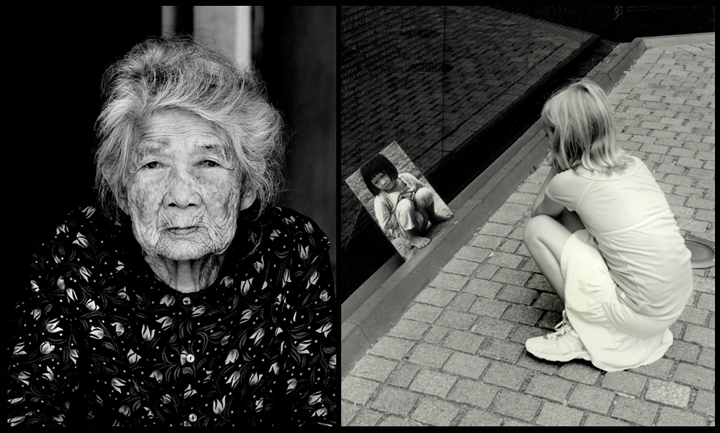
[ Two of Mike Hastie’s Vietnam-related images. Left, in 2018, a portrait of 93-year-old My Lai survivor Ha Thi Quy, and, at right, a touching juxtaposition of squats on Memorial Day at the Vietnam Wall in Washington D.C. Hastie suggests Memorial Day should be called Forgetting Day. ]
To me, there is no better statement of the process of life and the eternal conversation between conservatism and change than the following lines from “Song of Myself”:
But I do not talk of beginnings and the end.
There never was any more inception than there is now,
Nor any more youth or age than there is now;
And will never be any more perfection than there is now,
Nor any more heaven or hell than there is now.
Urge and urge and urge,
Always the procreant urge of the world. . . .
Has any one supposed it lucky to be born?
I hasten to inform him or her it is just as lucky to die, and I know it.
I pass death with the dying, and birth with the new-washed babe. . . .
And am not contained between my hat and boots. . . .
I bequeath myself to the dirt to grow from the grass I love,
If you want me again look for me under your bootsoles.
Do I contradict myself?
Very well then . . . I contradict myself;
I am large . . . I contain multitudes.
The Anti-War/Peace Boogie
For some time, I’ve felt the absurdity of seeking peace and trying to stop bloody wars foisted on America by political hacks and scoundrels. I’ve done this for over 35 years as a member of Veterans For Peace. Doing this in America, you feel a bit like Sisyphus, that mythic Greek doomed to push a big rock up a hill, only to have it roll back down, then to have to push it back up — for eternity. You become quite familiar with that rock; you even grow to ironically love that rock.
You think about it enough and, after while, the problem becomes very simple: In a pure, distilled sense, those seeking peace are peace-loving people — while those seeking war are war-loving people. Too simple? Peace-lovers may be full-on pacifists or they may just see non-violence as a preferred tool in the pursuit of peace; but they’re peaceful people. There aren’t a lot of violent, sadistic bullies and psychopaths in the peace-movement. Meanwhile, those on the other side, those designing and defending our wars and, thus, advocating violence as a tool in the pursuit of national policies . . . well, they feel they can’t do much of anything without violence or, at least, the threat of violence. They will, of course, tell you the opposite, that they hate violence even more than you do, which is why violence is necessary — to protect delusional non-violent fools like you. This is the front line in the absurd war of ideas we’re currently engaged in.
Back in the rear, behind the front lines, it gets more abstract, more confusing and more morally gray. We all know how war eliminates complexity and nuance, and that the first casualty is truth. That’s especially true back “in the world” where American citizens tend to do their best to remain ignorant of the horrific, granular details of US wars, those haunting images and smells the Mike Hasties of the world can’t get out of their minds — as Americans at home go about their lives searching for more comfort and the latest, fashionable thing. Sometimes, these homeland warriors can be the most bloodthirsty of all.
It can also get quite Orwellian. I once had a chat with General Stanley McChrystal when he was pushing a book; I told him I was a Vietnam veteran who has worked in the peace movement for 35 years. His response was to say, “I feel like I’ve been in the peace movement for 35 years.” I laughed, covered my mouth and made a mock sputtering sound. “What are you talking about?” He smiled and listed all the humanitarian functions of a modern US military force: building hospitals and schools and, in Afghanistan, working for women’s rights. The US military as an instrument of feminism? He was serious. This is the modern, absurdist world of spin, double-speak and outright bullshit. War is Peace. Like the slogan of the Strategic Air Command with all its B52s loaded with nuclear bombs: Peace Is Our Profession.
All this confusion raises the question: What does one do to oppose and question a type of war-making that more and more relies on the use of non-lethal weapons and focuses more and more on intimidating oppositional activity and confusing the moral atmosphere? What do you do when that kind of war — until now restricted to “over there” — comes home to roost in your domestic world? When the war-like conflict enters the cyber space of one’s i-phone networks? What do we do when — like mythic American western heroes in some dusty street — peace-movement devotees of the First Amendment come face-to-face with war-movement devotees of the Second Amendment? What do we do? Throw our pens at them as they gun us down with AR15s?
I exchanged emails with Hastie on all this, especially the video of him being painfully — but non-lethally — neutralized for non-violently (albeit loudly) speaking his truth. Mike mentioned the many Twitter comments from people that watched his assault video: “[T]hey focus on the person and not the message, because their core belief system couldn’t handle it. Therefore, something is wrong with me.” Since so many people are unwilling or unable to empathize with his experiences vis-a-vis Vietnam and the Vietnamese, there must be something wrong with him. He’s over the top. He’s being a whiner, while the men and women in rhinoceros garb are just doing their jobs.
Hastie, then, wrote me the following to further explain himself:
What I did in that viral video is tell the absolute truth, that the United States Government committed Atrocities every single day during the entire time that the U.S. Military was in Viet Nam. The U.S. didn’t commit atrocities every other day in Viet Nam, they committed atrocities every single day! If I started telling atrocities stories that I know of that have been told to me by so many Viet Nam veterans, I would be having a very long conversation. . . . I can give detailed information that would make you cry your heart out. Anybody who thinks I was over the top with my anger, needs to hear those stories in detail. The United States Military slaughtered innocent Vietnamese civilians every single day. Over the top??? When I’m done telling these stories, and reading detailed information by eye-witness Vietnamese, the doubting listener will probably have to leave the room. The U.S. Air War in Viet Nam was absolutely barbaric, as nothing was off limits, absolutely nothing. Vietnamese children died by the thousands, as these bombs tore their bodies to pieces! And, when it comes to artillery rounds, the U.S. fired millions of rounds.
Again, people like Mike Hastie — sensitive people like Walt Whitman — see life as a living process, not as politics or nationalism or personal pride or tribalism or through the really troubling aspects of human psychology like sadism and all the other abuses of power that are accentuated in war. Hastie was a kid raised by a combat veteran with what we now call PTSD; when that kid became old enough, he ended up in the violent world of the Vietnam War as a medical person inclined to heal — not to kill. He learned something unforgettable from the experience.
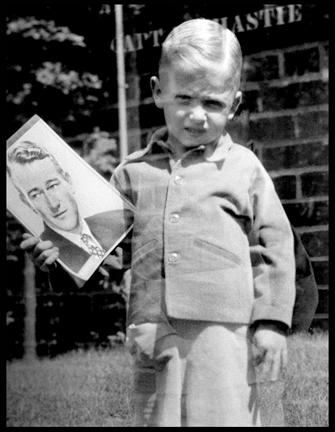
[ Mike Hastie on his first day of Kindergarten in 1950 when his father was a career military officer. Mike’s holding a notebook with a cover photo of John Wayne, a man who avoided real war but “won” a lot of them on the silver screen, including Vietnam in The Green Berets, which he starred in and directed, considered maybe the silliest Vietnam War film ever made. ]
So we end up with a Vietnam veteran poet with a camera suddenly encountering men and women in rhinoceros armor right out of Eugene Ionesco’s play about the rise of fascism in Europe 70 years ago. Their purpose is to shut him up and make him want to run and hide — so no one will listen to what he has to say and the status quo of power will not be affected. Authentic change will be averted.
Portland is important, and those there in the street need to have their message respected. One determined Vietnam vet poet with a camera has helped make that case. He and many others like him know too damn well things are not great and, in fact, they never were as great as the comfortable-class’ boilerplate American PR would have it.
All you gotta do is look at Mike Hastie with that painful, non-lethal pepper slime in his eyes to realize, the truth hurts.
Coda
Here’s three of Mike Hastie’s people images, the first, a very confident African American man framing a sign that completes the composition. Then, a sleeping man securing his very precious bicycle. Finally, a serious masked woman with a message about Black Lives Matter.
